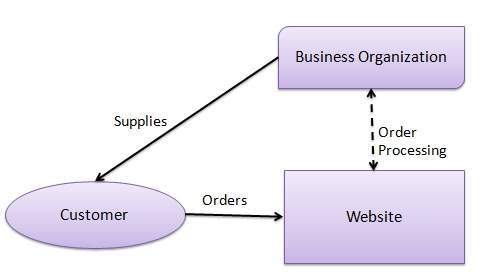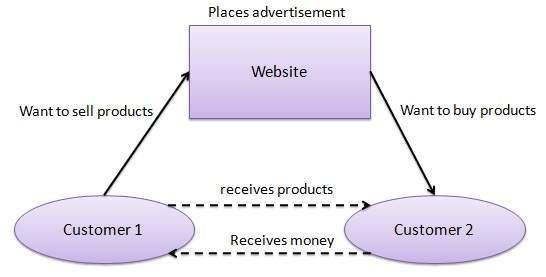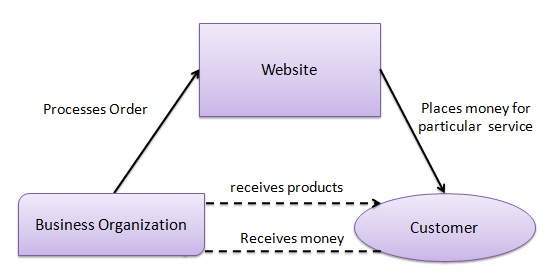Business - to - Business
A website following the B2B business model sells its products to an intermediate buyer who then sells the product to the final customer. As an example, a wholesaler places an order from a company's website and after receiving the consignment, sells the endproduct to the final customer who comes to buy the product at one of its retail outlets.

Types
1. Sell-side. One seller to many buyers.
2. Buy-side. One buyer from many sellers.
3. Intermediatory. Many sellers to many buyers through intermediatory platform
Business - to - Consumer
A website following the B2C business model sells its products directly to a customer. A customer can view the products shown on the website. The customer can choose a product and order the same. The website will then send a notification to the business organization via email and the organization will dispatch the product/goods to the customer.

Consumer - to - Consumer
A website following the C2C business model helps consumers to sell their assets like residential property, cars, motorcycles, etc., or rent a room by publishing their information on the website. Website may or may not charge the consumer for its services. Another consumer may opt to buy the product of the first customer by viewing the post/advertisement on the website.

Consumer - to - Business
In this model, a consumer approaches a website showing multiple business organizations for a particular service. The consumer places an estimate of amount he/she wants to spend for a particular service. For example, the comparison of interest rates of personal loan/car loan provided by various banks via websites. A business organization who fulfills the consumer's requirement within the specified budget, approaches the customer and provides its services.

Business - to - Government
B2G model is a variant of B2B model. Such websites are used by governments to trade and exchange information with various business organizations. Such websites are accredited by the government and provide a medium to businesses to submit application forms to the government.

Government - to - Business
Governments use B2G model websites to approach business organizations. Such websites support auctions, tenders, and application submission functionalities.

Government - to - Citizen
Governments use G2C model websites to approach citizen in general. Such websites support auctions of vehicles, machinery, or any other material. Such website also provides services like registration for birth, marriage or death certificates. The main objective of G2C websites is to reduce the average time for fulfilling citizen’s requests for various government services.

Company Examples
B2B firms: Indiamart, Alibaba, cisco
B2C: Flipcart, Snapdeal.
C2C: OLX, QUIKR
C2B : pricelane.com, policybazar.com
Electronic tendering systems.
Large organizational buyers usually make large-volume or large-value purchases through a tendering (bidding) system, also known as a reverse auction . Such tendering can be done online, saving time and money.
Viral marketing.
According to the viral marketing model , people use e-mail and social networks to spread word-of-
mouth advertising. It is basically Web-based word-of- mouth advertising, and is popular in social networks
Group purchasing
Group purchasing is a well-known method, both in B2C and B2B. It is based on the concept of quantity discounts (“cheaper by the dozen”). The Internet model allows individuals to get together, so they can gain the large-quantity advantage.
Brokerage: Market makers that charges fee
for their services.
Advertising: Websites that provide content
and charge advertisers for related ads.
Infomediary: Provide information and/or
infrastructure that help buyers and/or sellers
and charge for their services.
Merchant: Retailers (such as Walmart or
Amazon): These buy the products and sell
them at profit.
Direct model: Sell without intermediaries.
Affiliate: Paying website owners to place banners.
Share fees received from advertisers.
Community: A social media-based model that
utilizes Web 2.0 tools, social networks, and
the characteristics.








0 Comment to "E-COMMERCE BUSINESS MODELS"
Post a Comment